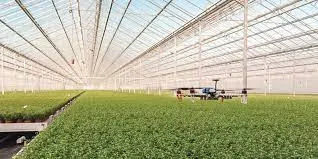Smart greenhouses are the next revolution in digital agriculture
The global commercial market size of greenhouse agriculture was estimated at $29.6 billion in 2020, and is expected to reach $50.6 billion by 2025, registering a compound annual growth rate of 11.3% during this period, according to the platform . Markets and Markets" in a recent report.
The growth of this sector is due to the increased demand for food due to the increasing population in the world year after year, in addition to climate change that affects the volume of global agricultural crop yields. Technological development and increased dependence on various digital farming methods will provide great opportunities for the growth of this vital sector for humanity In the future, as scientists and researchers from different countries of the world conduct scientific studies and agricultural research to reduce costs on the one hand and increase production on the other hand, within these increasingly widespread greenhouses around the world.
A recent study - recently published in the journal Plants - showed that the use of an intelligent control system inside a greenhouse (greenhouse) can improve lighting for cultivated plants by predicting sunlight and turning on the lights only when needed. The data showed that farmers can reduce the cost of using electricity inside these homes by up to 33% by improving the lighting systems used inside them.
Unintelligent lighting systems cost hundreds of millions of dollars
On rainy or cloudy days when the sun does not set, plants are given supplemental lighting to compensate for the lack of sunlight necessary for their growth. Although effective, these lights can be expensive, ineffective, and consume large amounts of electricity.
A 2017 report from the US Department of Energy estimated that lighting systems used to grow plants inside greenhouses consume about $600 million in electricity each year.
"When LED light bulbs first appeared on the market, they gave us the opportunity to control greenhouse lighting at a level that was not possible before," said Mark Van Ersel, a professor in the College of Agricultural and Environmental Sciences at the University of Georgia.
"At that time, a lot of research was being done to improve the lighting itself, but almost no one was working on intelligent control technology in the lighting systems used at the time," he added.
"The cost of electricity used for lighting in a greenhouse is between 10 and 30% of the operating cost, and our research began with the idea that if we could reduce this cost, we could very quickly affect the efficiency and sustainability of the greenhouse," Ercel explained.
intelligent lighting system
A team of researchers at the American University of Georgia has designed a new smart lighting system that can reduce electricity consumption in greenhouses without harming plants and their growth opportunities, according to what the university recently published on its platform.
Shirin Avazli, a master's student at the Faculty of Electrical Engineering, built a control system that uses smart sensors to measure current weather conditions, while doctoral student Sahand Musharfian, with the help of Professor Javad Muhammadpour Vilni, developed special algorithms for light prediction in the university's laboratories. Together, the two systems can predict how much sunlight plants need to thrive; Which allows to improve the lighting inside the greenhouses and give the plants the right amount of light.
Greenhouses are used to produce plants from fruits and vegetables mostly during the winter and spring when the sun goes down due to rain and changing weather conditions, so the team tested their system during these two growing seasons.
While both experiments showed lower costs while maintaining healthy plant growth, the new system had a greater impact during the spring, where costs were reduced by 33%, but efficiency dropped to only 4% during the winter due to the almost complete absence of sun.
The actual savings are much higher
The research team confirmed that the actual savings could be much higher on the ground, as their experiments assumed fixed prices for electricity, something that does not always happen in the real world, where prices change continuously, and are usually much higher in the winter and spring than in the fall and summer. The team has already programmed the system to account for this variable, and plans to publish future research showing significantly higher savings rates.
As the planet's population continues to rise, the Earth's population is expected to reach about 10 billion people in 2050; Finding smart ways to produce more food with fewer resources is becoming increasingly important, which makes the use of technology and smart systems in agriculture inevitable in the future.
Herein lies the importance of this research, which is a new building block in the edifice of what has become widely known as digital agriculture that relies on algorithms, artificial intelligence and cloud computing to produce more food to cover the increasing need of humans day after day.
Tags:
BIODATA


